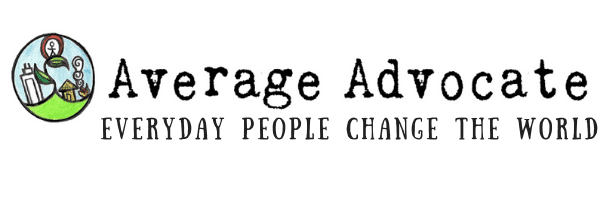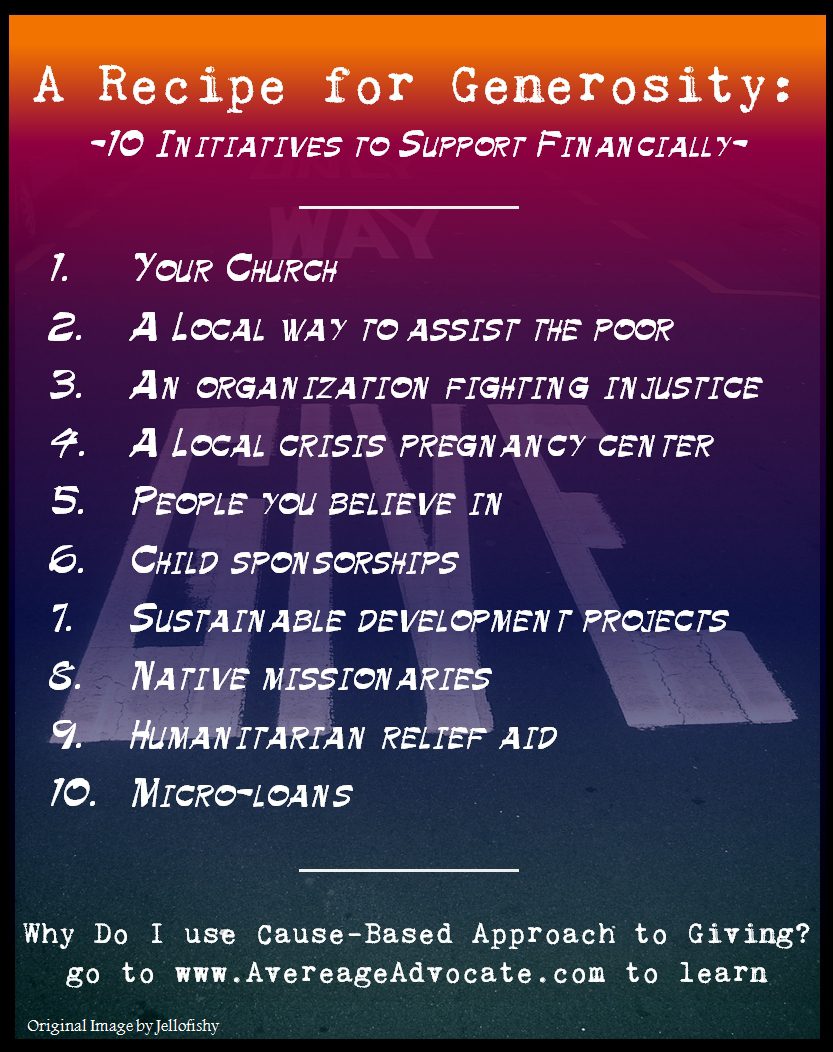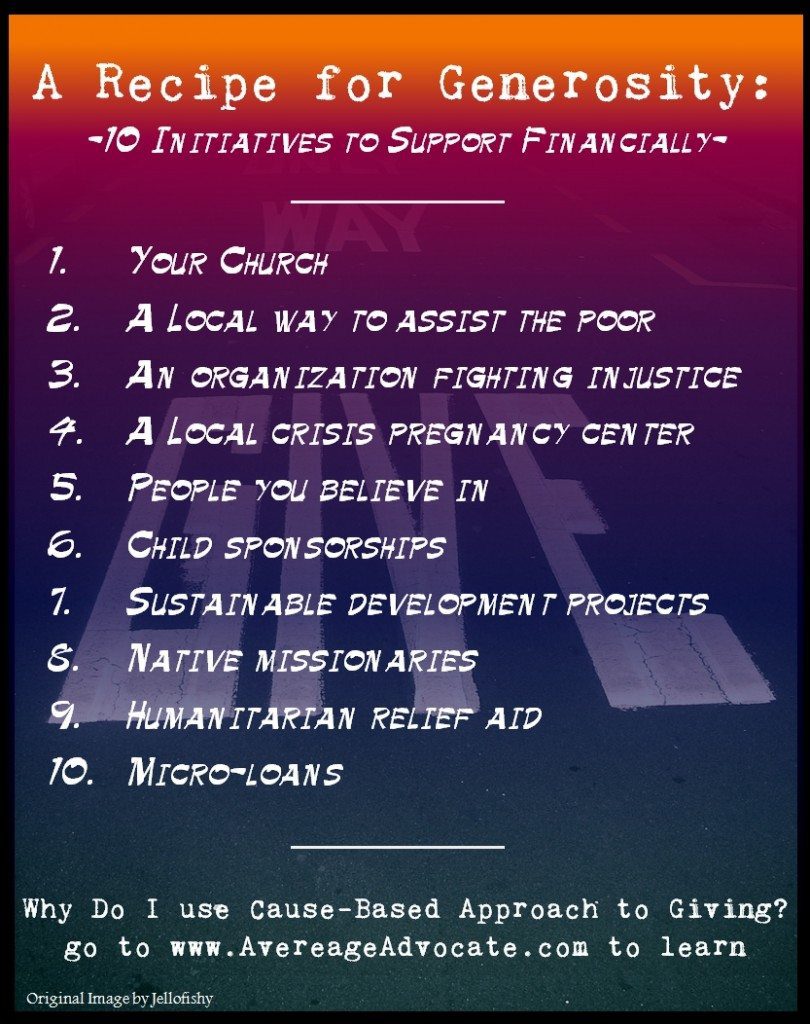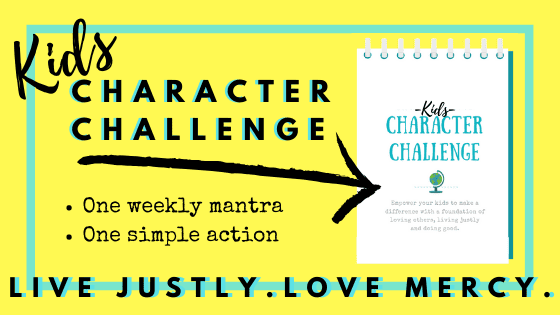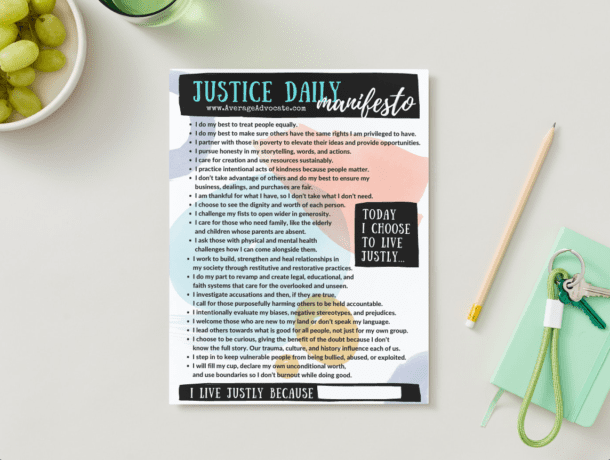A couple years ago, I was asked by a wonderful individual who are the top ten charities we give to and why. Although I wrote this post right away, I never published it. But now I realize I needed to answer it differently, although just slightly–what are our top ten causes to give to. This is because my family uses a cause approach to giving.
I wanted to be sure this was published, and not just because I did a #GivingTuesday scope about being generous in which I referred back to this never posted post. Why? Giving is important. More than that, being generous is essential if we are going to be part of changing the world. And how can we be generous if we don’t know where to give?
It seemed like it would be a simple one through ten list to write of where to give. Yet as I thought about it, half of where we give financially isn’t really where I would recommend others to give. Those organizations are relevant to my life, not necessarily everyone else’s lives.
Donating to the Cause Rather Than the Organization
The more I thought about it, the more I recognized that my family usually gives by category and cause rather than specific organizations (even though often the organizations are the same).
I didn’t know this was an atypical approach until I first started doing crowdfunding through the Little Black Dress Project. I had chosen to use Crowdrise, but soon discovered that I couldn’t just donate to a cause–I could only donate to an organization’s general fund. I had to switch organizations a few times until I found one that would work with me directly to take our donations, applying our funds to the specific cause we were fundraising for (at that time, it was the 2011 famine in the Horn of Africa). As I researched more, I discovered that most people seem to give based on the charity itself, rather to the specific cause. Most fundraising platforms, 5Ks, and other events/projects are set up this way too.
Why I Use A Cause-Based Framework for Giving
There are three reasons I like to donate money to specific purposes that are important to me rather than just committing to giving to particular organizations.
One of these is because it would make no sense for you to give to my community, when your own community needs your generosity. I think we have a personal responsibility to love locally. I have said a bazillion times and will always say that my heart dwells internationally, as the instances of oppression and extreme poverty are exponential in the developing world. But that doesn’t absolve me of ignoring those who need love around me–how can I be faithful with what is far away if I refuse to consider those on my doorstep? Also, if I am to model loving others, I usually have to do that in person, in real life. Changing our little corners of the world is the first step in inspiring those watching us to love beyond borders.
[inlinetweet prefix=”” tweeter=”@AverageAdvocate” suffix=””]The best way to inspire others to change the world is to invite them to care for others with you locally.[/inlinetweet]
I can’t recommend all my top ten organizations, as many of my top ten are particular to my community.
The second reason I can’t recommend a top-ten list, is that there are valid personal opportunities we each are asked to give to. These pop-up spontaneous opportunities are unique and come from our circle of family and friends–people we need to love in their crisis, empower in their next step, or believe in their mission. In our household, I’d venture to say a at least one-third of our giving goes towards specific personal requests and needs.
[inlinetweet prefix=”” tweeter=”@AverageAdocate” suffix=””]If all our money set aside to give is committed to an organization every month, we loose the margin to give to specific needs we hear about.[/inlinetweet]
Lastly, it is easier to use a cause-based format to give because sometimes organizations change. An organization we’ve been donating could have fallen a star on Charity Navigator. A non-profit’s focus could have stopped working to help the thing we care about. Or maybe an org we like doesn’t have an opportunity for us to give to a specific cause that is weighing heavily on us that day–such as the Nuba refugees in South Sudan, or restoration work for child soldiers.
For example, with the ALS Bucket Challenge, various people told me they didn’t want to give because the ALS Association uses embryonic stem-cells for research (although there is an option to make sure your money specifically isn’t used for this, if that is a concern). But when we take a cause-based approach rather than an organization-based approach, this ceases to be a problem. Not surprisingly, there are other organizations to donate to which do not use embryonic stem cell research in their ALS patient care or research.
Essentially, it comes down to this: we have flexibility to use our giving margin when we are not necessarily committed to sending a check to the same organization each month for twenty years (although some organizations we do choose to do this with). Even so, there are ten causes we always find valuable to give to, which I will list below.
Top Ten Causes To Give Generously To
Without further ado, here are the top ten causes we donate to, and some examples of what organizations I particularly like which are applicable to these causes:
1.) My Local Church
As this is our local family, community, where others invest in us and we in them. It is undoubtedly at the top of my family’s list to give to. Many choose to give 10% to their local church, based off of the Old Testament tithing principle (which actually went to priests and to fund parties for the poor–read about it here). In the New Testament though, we are just asked to be generous and Jesus respected percentage giving. So, if you have a church, or similar community, choose a percentage to start with and make it home.
2.) A Local Way to Help the Poor
I like to regularly give to something alleviating poverty locally. For many years this was through the L2F needs network I was the coordinator for. We’d provide for local children when we learned about their needs through our relationships with their schools. This also included weekly relief food aid–I loved this program and still enjoy consulting on how to start a weekend backpack program. There are also a few other local organizations focusing on the root causes of poverty we supported, through mentorship, teaching ESL, job training, and other life skills to help parents/adults out of poverty.
3.) An Organization Fighting Injustice
I highly recommend giving to organizations that fight injustice both around the globe and locally. Making a stand, declaring that we won’t tolerate injustice goes a long way to reduce corruption on a global level. Although there are other organizations, like Amnesty International, A21 Campaign and Love 146 that we have given to, I love the model International Justice Mission uses. They use their connection in government and their prestige as lawyers to demand justice from the higher authorities in a location, until someone pays attention to their proof that such injustice is happening under their jurisdiction. The result is that corruption is diminished, justice becomes the thing, and people are pulled out of all types of situations where they were being abused by oppression.
Ironically, we are often unaware of injustice happening locally, usually focusing on where it is most pronounced on the other side of the world. Either that, or we assume politics and law enforcement take care of it, not recognizing our political system and laws might not be effective enough to carry out justice. Also, although there might be local organizations, more often than not they are small, overworked, and underfunded. This is why I helped start, directed, and now am on the board of the Northern Virgina Human Trafficking Initiative.
Most places have small groups or organizations rising up to fight local injustice. Search for them. Support them.
4.) A local crisis-pregnancy center
For us, this was Mosaic, or the 1st Choice Women’s Care Center (although now we have moved, I am learning about the local one by us in San Diego). Why a crisis-pregnancy center (especially if you don’t care about abortion)? Working as a lay-counselor volunteer at the above mentioned crisis pregnancy center, I saw lives change and watched women to be empowered to make the choice they wanted to make (I only met one woman in over two years who still wanted to have an abortion after we offered her help and understanding). I saw these women thrive with love and counseling, and in some cases, as a result, new little people came into the world too!
For me, this is just another way to love the people in my area. There are girls and women around me all the time finding themselves in a scary, overwhelming situation with little to no community support in a culture that often judges and abandons singles with unplanned pregnancies. Until that changes, I feel like I can stand by these women, even if it is just through our financial gifts. There are been many instances I have been able to refer people to this organization in their crisis pregnancy. But they only had access to this free resource because people help fund it.
5.) People I believe in
I already spoke about this earlier, as one of the reasons we should give to causes rather than simply organizations. For us, these are examples of what this might look like:
- The friend who needs repairs on their car
- The Kickstarter campaign for that weird project
- The mission trip to Uganda
- The walk-a-thon for some obscure–but important–disease
- The guy on the side of the road who ran out of gas
6.) Committing to Child Sponsorship
This commitment worth it, as it really provides a means for children to both survive and eventually provide for themselves. I recently had an experience with a child sponsorship program that made such a difference on the community that it wasn’t needed anymore–you can read about this here A Farewell Letter to my Sponsor Child and here–Are You a Terrible Parent to Your Sponsor Child?
7.) Sustainable Development Projects
Although child sponsorship usually is a sustainable project, we usually give to other specific projects that have a long-term impact in addition. These are the types of things that create lasting change, helping people break out of the cycles of violence or/and poverty and take care of themselves. Water-wells/maintenance crews and agricultural efforts–seeds, fertilizers, irrigation systems–are examples of sustainable development projects. Developing schools and investing in education, the justice system, job training, and other types of things would also qualify in these categories. Large organizations (World Help, MAP International, World Vision, Compassion, Samaritan’s Purse, Heifer International) and missions agencies both large and small (Gospel for Asia, Gospel Revival Ministries) take on projects like these.
There are also many non-profits dedicated to a specific type of work. For example, Pencils for Promise creates education opportunities for children around the globe. Plant with Purpose is also great, doing a lot of development work and although Food for the Hungry isn’t a 4 star charity, I like their model of working with the poor. You can look here for some of the many organizations for clean water.
8.) Native missionaries
I believe that sustainable hope doesn’t come from food, medical care, education, or clothing (although those lend to a vital but temporary hope that shouldn’t be overlooked). Rather, hope is rooted in a spiritual faith.
For example, yesterday I heard a report from Voice of the Martyrs, an organization that helps local missionaries in areas of extreme religious persecution. A representative noticed a wailing woman–out of desperation she had just sacrificed her baby by throwing him to a river god in India. He gave her spiritual hope as well as helped meet her physical needs. After the encounter, she cried, wishing she had met him half an hour earlier so her baby would still be alive. This woman needed hope.
After studying cultural anthropology, I have discovered that sharing my faith isn’t forcing myself on anyone, rather, it is giving an opportunity to experience a life of hope rather than living under judgement and desperation. Because of this, we support organizations that actively share our faith–in a non-manipulative fashion–alongside the loving good things they do to support and develop the areas they are working in.
We choose to support locals, or native-to-the-area missionaries, because they cost a fraction of the amount it takes to send a Westerner. In addition, we don’t want to impose ourselves as saviors, as if we are better, or bringing in extra-biblical religious traditions. Rather, we want to help people in the area share their own faith, without cultural barriers, which has a much greater impact.
9.) Humanitarian Relief Aid
We can’t overlook humanitarian aid, because without it people will die before anyone has a chance to foster sustainable development.
The first year we did the Little Black Dress Project, it wasn’t actually for human trafficking, but it was for a famine in Africa where tens of thousands were dying. There are famines, hurricanes, tornadoes, earthquakes, and wars which require immediate relief before any development or employment can even be put on the table to consider. For example, if you read this post about the Syrian refugee crisis, it is obvious how great of a need there is for relief work and humanitarian aid.
Direct Relief and Action Against Hunger (along with all those other big orgs I already mentioned under #7) are some of the best at international humanitarian relief aid.
10.) Microloans
Thankfully, not too terribly long ago it was decided by all the smart people in the world that the most effective way to alleviate poverty is by helping give people a hand-up to start making a profit. This concept–lending to the poor–is actually something commanded in the Bible as a way to love and care for the people of Israel when it was becoming a nation.
There is a reason this works. I give money. They use the money, make the money back, and then I can give it out again (and again, and again). We always have a chunk of money set-aside in this cycle.
We usually do this through Kiva.org, though I pretty much only give to women, and investments where a profit can be made. If I can figure it out, I also look for very low interest rates, or for the loan to be given through another organization I trust but still have it given through my Kiva profile for easy management. For example, sometimes I will search on Kiva for a World Vision microloan–although you can also get microloans via World Vision’s website).
11.) Orphans or Foster Care
This wasn’t on my original recipe for generosity, but it is something we’ve supporting on-and-off for years. I believe children in need ideally should stay within their own communities when possible, but there is still a huge need in the United States for foster care parents, and globally, much of the orphan care system needs to be revamped. There are organizations and individuals fighting for the orphan, and this takes finances!
A Recipe for Generosity
You can use the above recipe for generosity, like we do. Or you can make your own recipe for generosity to help you be intentional about cause-based giving. Regardless, make a plan and choose a percentage to give.
Let us know in the comments what you would add to or change for your own top ten list of causes to give to. I hope this helps you become a person of generosity!
Again, here is this pic you can print or pin to help you as you make your own giving plan:
